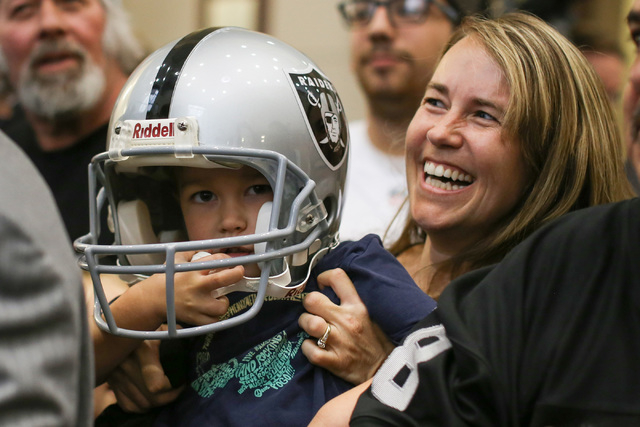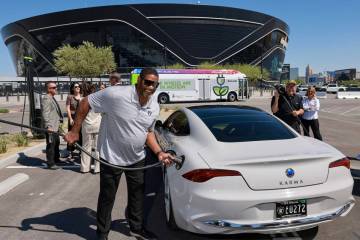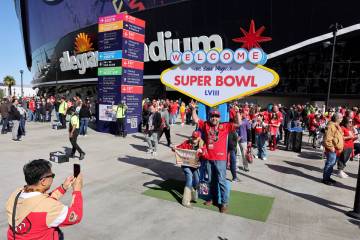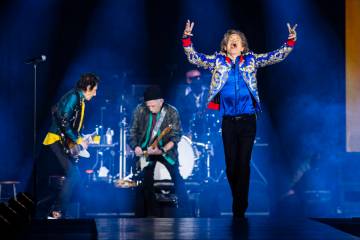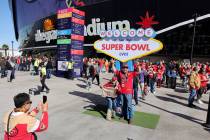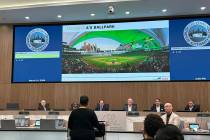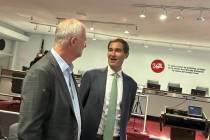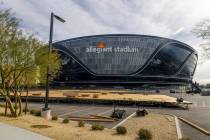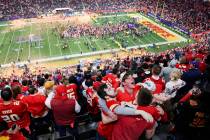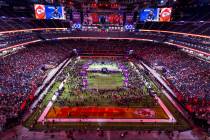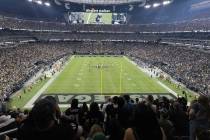Southern Nevada committee to work on funding $1.4 billion stadium
When the 11-member Southern Nevada Tourism Infrastructure Committee begins work Thursday on how to pay for a $1.4 billion, 65,000-seat domed stadium, it will try to piece together a funding strategy that will keep everyone happy with their return on investment.
Don’t count on that being an easy task.
And don’t count on the stadium being a done deal.
Some critics of the stadium proposal already have made their position perfectly clear — don’t contribute a single dime of taxpayer money toward a project that’s bound to generate profits for developer Las Vegas Sands Corp. and the Oakland — or is it Las Vegas? — Raiders.
The pro-stadium side is equally passionate. An indoor football stadium is a genuine need that can boost Southern Nevada’s tourism economy, they say. Southern Nevada is missing out on many entertainment acts and athletic events because of the lack of a large venue.
A new stadium also would solve a longtime problem that has vexed the University of Nevada, Las Vegas: the lack of a stadium close to campus that would boost student support and advance the prominence of an athletic program with major-conference ambitions.
Attracting the Raiders to Las Vegas, in the eyes of supporters, would be icing on the cake. The venue can be a success without an NFL tenant, stadium backers say. But it sure would be nice for Las Vegas to join that elite club of cities that have a team in the nation’s most popular team sports league.
Steve Hill, director of the Governor’s Office of Economic Development and chairman of the committee tasked with forwarding recommendations on tourism infrastructure improvements to Gov. Brian Sandoval, said the financing package is so complex that he expects at least two more meetings after Thursday’s session to complete it.
OPTION CALLS FOR 54-46 SPLIT
When Las Vegas Sands and Majestic Realty rolled out plans to build a stadium on 42 acres just east of the MGM Grand at Tropicana Avenue and Koval Lane, they hired Conventions, Sports & Leisure International of Plano, Texas, to guide the committee through possible financing options.
Bill Rhoda, president of CSL, has presented details of those options and has shown how stadium developers in other cities have financed their projects.
CSL has worked on 31 professional football stadiums since its founding in 1988, including the new homes of the NFL’s San Francisco 49ers and Minnesota Vikings. Closer to Las Vegas, the company also worked on Aces Ballpark, the minor league baseball stadium in downtown Reno.
On the table in Las Vegas is a public-private partnership calling for $750 million from the public and $650 million from the private sector, or a 54 percent-46 percent split.
From the private partners would come a $500 million contribution from the Raiders — $300 million of that in the form of a loan from the NFL — and $150 million from casino operator Las Vegas Sands and Majestic. The exact sources of the $750 million in public money remains unsettled. That’s where much of the detail work remains.
The key question: Is the deal fair to all parties?
Rhoda identified 46 annual events at the stadium if the NFL is in the mix. They include 10 home NFL football dates (two preseason and eight regular-season NFL games), six UNLV football dates, two college football bowl games (including the current Las Vegas Bowl), two neutral-site college football games, two soccer events, four rugby events, three motorsports events and one top-draw boxing or mixed martial arts event.
How the country's newest professional football stadiums were financed
Levi's Stadium
Santa Clara, California
Capacity: 68,500
Completed: 2014
Cost: $1.3 billion
Private funding: 99%
Public funding: 1%
University of Phoenix Stadium
Glendale, Arizona
Capacity: 62,400
Completed: 2014
Cost: $439.7 million
Private funding: 68%
Public funding: 32%
AT&T Stadium
Arlington, Texas
Capacity: 80,000
Completed: 2009
Cost: $1.3 billion
Private funding: 64%
Public funding: 36%
NRG Stadium
Houston, Texas
Capacity: 71,054
Completed: 2002
Cost: $449 million
Private funding: 57%
Public funding: 43%
US Bank Stadium
Minneapolis, Minnesota
Capacity: 68,500
Completed: 2016
Cost: $1.1 billion
Private funding: 55%
Public funding: 45%
MetLife Stadium
East Rutherford, New Jersey
Capacity: 82,566
Completed: 2010
Cost: $1.6 billion
Private funding: 100%
Public funding: 0%
Mercedes-Benz Stadium
Atlanta, Georgia
Capacity: 75,000
Completed: 2017
Cost: $1.5 billion
Private funding: 84%
Public funding: 16%
Source: Convention, Sports & Leisure International, Plano, Texas
Gabriel Utasi/LAS VEGAS REVIEW-JOURNAL
Hill said the number of events staged will drive the economics.
“Do we think we can get to 46? What we’ll probably do is carve 10 events out and see what that looks like and then carve another 10 out and see what that looks like,” he said. “We have to stress-test the model, maybe take it from 46 to 20 or somewhere in between and get a range of potential outcomes.”
Guessing right on the number of events the stadium could hold is critical to determining return on investment and whether the amount of money plowed into the facility would be worth it to taxpayers, who stand to see less money available for schools, roads, parks and other projects tax revenues currently support.
But the upside would be more money for those needs and projects if the stadium does what proponents say it will.
ANSWERS NEEDED BY JULY 31
CSL estimated an average turnstile attendance of 40,000 at those 46 events, resulting in an estimated 1.8 million visitors and 845,000 new hotel room nights.
The CSL report noted that spending by visitors at events consists of in-stadium spending on tickets, concessions, merchandise and parking, as well as out-of-stadium spending on lodging, food and beverage, shopping, entertainment, transportation, gaming and other services. The report estimates per-capita out-of-stadium spending by overnight visitors at $642 per person per day, and 65 percent of out-of-stadium visitor spending is considered “net new” — it would not be spent without the presence of the stadium.
When the committee meets Thursday, it will dig into four pages of detailed questions the group wants answered before buying into public stadium support. Among them: Is the UNLV site an appropriate location? What portion, if any, of the cost should be paid by the public? What happens if stadium revenues fall short? Is it reasonable to expect 46 events per year?
The committee is working toward a July 31 deadline to make its recommendations. A $1.4 billion Las Vegas Convention Center expansion project and several transit proposals are also under consideration.
“I think wrapping something up (on the stadium) before July is not possible,” Hill said. “I’ve even asked the committee to reserve a date between the June and July meetings to continue to work on it.”
In addition to determining whether the existing tax structure pencils out as a wise return on investment, the committee probably will look at whether the Legislature should be asked to increase tax rates on existing services. Committee members already have indicated they have little appetite for bumping up taxes that would directly affect local residents, especially because locals would pay more through the live entertainment tax if a stadium is built.
WHERE DOES BURDEN FALL?
In theory, generating tax revenue through hotel room and rental car rates shifts most of the burden to visitors, though residents occasionally rent vehicles or land in resorts for “staycations.” But for entertainment events, there is no chance for locals to dodge the live entertainment tax currently imposed.
County hotel room and car rental tax revenue is expected to climb, as would their corresponding state revenue: sales taxes, gaming taxes (officials anticipate sports fans would tend to gamble) and the state modified business tax, since new employees would be hired if the stadium is built and an NFL team were to relocate here.
There appears to be room to increase the room tax. Between the state and the county, the hotel room tax is at about 12 percent, just under Orlando’s 12.5 percent rate and Phoenix’s 12.57 percent. And it’s well below New York’s 14.75 percent rate, Dallas’ 15 percent, Chicago’s 16.39 percent and Houston’s 17 percent.
Committee members also could ask the Legislature to form a tax-increment district. The boundaries of a special tourism taxing district would be open to debate. Would it include only the stadium site’s 42 acres or would it include property around it? And if so, how far from the stadium would the district extend to grab revenues from businesses that would benefit from proximity to the stadium?
The CSL report suggested a TID to last 65 years and feed a stadium authority, which would operate much like the Las Vegas Convention and Visitors Authority, to build and manage the facility.
The committee will also look at how new stadiums have been funded. They include:
■ U.S. Bank Stadium, which this year will open as the home to the NFL’s Minnesota Vikings. About 45 percent of the 68,500-seat stadium’s $1.1 billion budget is being covered by taxpayers, with Minneapolis residents seeing a half-percentage-point increase in the sales tax and as much as a 3 percentage-point boost in taxes on liquor, lodging and restaurants through 2046. The state also authorized a tax exemption on construction materials for the stadium, which is also exempt from property taxes.
■ Mercedes-Benz Stadium in Atlanta, where the public is contributing only 16 percent of the cost of the $1.5 billion, 71,000-seat home of the Atlanta Falcons, to open in 2017. The Georgia General Assembly in 2010 approved the extension of a 7 percent tax on motel and hotel rooms through 2050 contingent on 39.3 percent of the revenue being used to build the stadium.
■ Levi’s Stadium, home to the San Francisco 49ers and host of February’s Super Bowl 50, cost $1.3 billion to build and seats 68,500. Only 1 percent of the cost was publicly financed. The city of Santa Clara, California, contributed $11 million. Prepayment of luxury boxes supporting a Goldman Sachs-led loan from 17 lenders covered most of the bill.
Examining those projects and others may generate new ideas, but the core issue in Las Vegas is whether the stadium plan is fair and whether the public will share the benefits if the stadium is a roaring success.
“This should be a business conversation, an economic conversation,” Hill said. “So far, what we’ve talked about is more conceptual than getting into real detail — what’s the projected return on investment from the private side and what’s the economic benefit to the community for the public side and how to determine the definition of ‘fair’ and, separately, ‘smart?’”
“I think what you’ll find is that if we get 40 to 50 events, the stadium becomes pretty lucrative for everybody involved. We have to ask the question about the potential for the public to share in the upside. Early on, they (developers) said no, but that needs to be aired because the truth is that if it’s very successful, the return on investment will be very high. It would help to buy down the public investment.”
The Review-Journal is owned by the family of Las Vegas Sands Chairman and CEO Sheldon Adelson.
Contact Richard N. Velotta at rvelotta@reviewjournal.com or 702-477-3893. Find him on Twitter: @RickVelotta
RELATED ITEMS
No special session yet for Las Vegas stadium, lawmakers say



